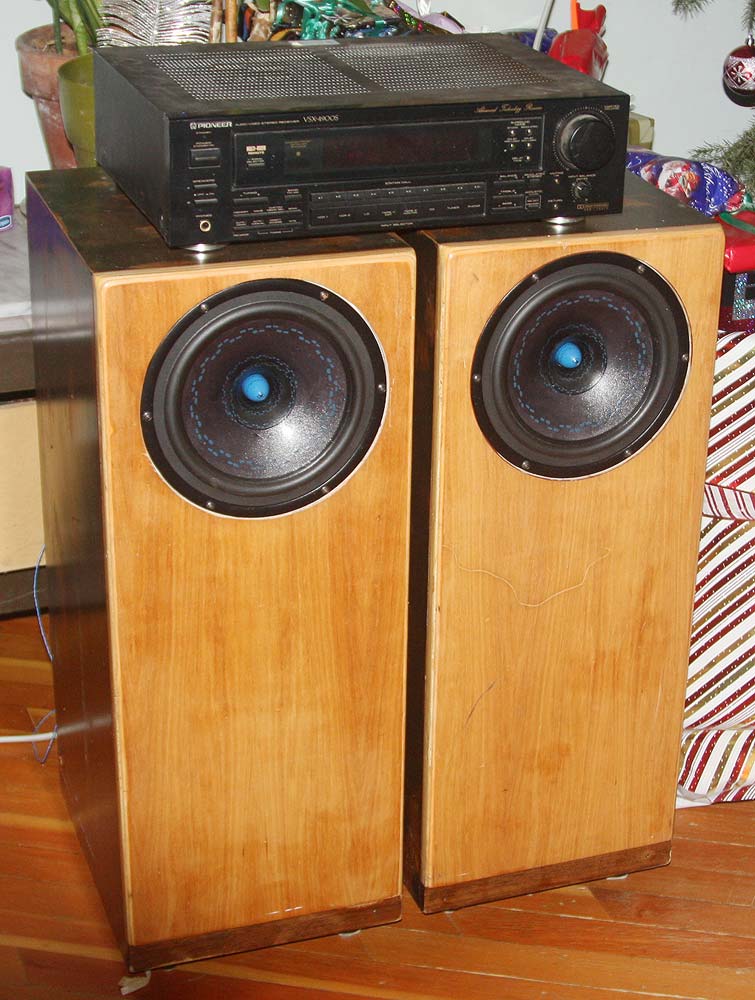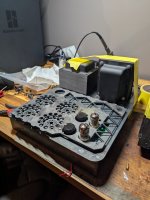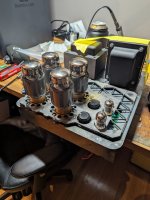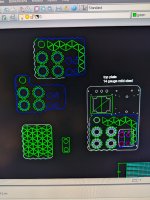Working on a few chassis parts for the M125s tonight. I'll start on transformer & tube shields next week most likely.
Attachments
These are my amplifiers on 211 triodes. First turn on.


SE/84 Brachycera






This amplifier I built is based on the first version of the Uraltone's construction kit https://en.uraltone.com/kits/hi-fi-kits/se-84-brachycera-by-mikko-kutvonen-v2-0.html with an unmachined case. I did not accept the finished housing of the version 2 for many reasons, most disturbed by the asymmetry of the front panel. I redesigned it, as well as the rear panel. I left out the 3.5 mm input on the front panel as unnecessary, but added a signal lamp for power (the glow of some tubes is not visible in sunlight, the lamp is visible better). There are five inputs on the back and a toggle switch for selecting the impedance of the speaker outputs instead of double plus terminals. The second switch selects the cathode resistors suitable for the type of output tubes, these are sized so that the anode power loss is 10W at the most commonly measured 233 volt mains voltage.
The sides of the cases are not completely straight after the factory, but they have been sanded straight. The top covers have been forged with a hammer and sanded straight, no filler has been used. Meshes made of aluminum, attached with strong adhesive. Reinforcement in the upper case with an L-shaped sheet metal (roof/front). Primer with 2-component epoxy, sanding, topcoat with 2-component acrylic velvet black. Front panel and mirror of the upper case made of polished stainless steel, nicely highlighting the tubes. The screwless top cover required the making of two separate frames (2 mm stainless steel), and inside the rear panel also a stainless steel plate as reinforcement.


Updated smaller subframe:

All the changes took up space inside and led to precise placement of parts. Due to lack of space, the connectors of the power connector, power and speaker mute switch were bent. Additional epoxy adhesive in the power connector and switch as voltage protection. There is a plastic plate on the side of the mains transformer near the power switch and indicator light as additional insulation. Don Audio's interference shield (grounded to the frame) around the transformer improves interference immunity. Due to lack of space, the hole in the mains transformer has been filled with epoxy glue, fixed with a recessed screw (under the rubber plate) instead of a mounting plate that would be higher.

The secondary voltages of the Indel mains transformer are generally high, but the problem has been solved with flange resistors: 270 ohm (1%) and for the heaters 2 x 0.15 ohm (1%). Now the operating voltage after the choke, the operating voltage of the pre-stage and the heater voltage are within the tolerances given by the designer.
The input cables are coaxial cable, the shielding is connected in a star pattern to the circuit board around the selector switch. The cable screw connections have end sleeves in the cables. The circuit board has raised sockets for mounting larger Miflex copper capacitors than the original ones. The cathode resistors of the power tubes are Vishay Dale RS series (1%), as is the voltage resistor of the preamplifier. For the 6P15P power tubes, Hazen mod, i.e. the cathode voltage is fed to the brake grid with a capacitor, does not affect the use of EL84 tubes. For the headphones, -11.7dB attenuation is implemented with Vishay Dale CPF series metal film resistors, reducing hum and appropriately limiting the power, making the volume knob's operating range wider. Without attenuation, the volume would be really loud at 9 o'clock. The headphone connector has gold-plated contacts, unlike the original. The tube bases are not gold-plated because the selection of tubes with gold-plated pins is very limited. All solderings is done with leaded tin (at 320 degrees) for maximum reliability.
Hammond 1444-22 and 1444-10 cases
Hammond 1434-22 base plate
case feet Banzai Music RFX-2515
Indel TSTL 120/001 mains transformer
Don Audio trafo shield for mains transformer
Hammond 157M choke
Hammond 125DSE output transformers
Schurter 6200 power connector
Banzai Music MI-NI-2YL indicator lamp
REAN NYS367 RCA connectors
Uraltone 435-BP-5-PC-RED-G and 435-BP-5-PC-BLACK-G speaker connectors
Cliff CL1323A headphone connector
NKK S6A toggle switches
Alpha SR2511F-0205-19R0B-E9-S input selector
Alps "blue" volume potentiometer RK27112A00AK + UralTone Alps RK27 circuit board
knobs Banzai Music Indira
tube sockets Belton VT9-PT
input cable CEAM RG174U
headphone attenuation resistors Vishay Dale CPF26R1900FKB14 and CPF12R2100FKB14
secondary voltage limiting resistor Vishay Dale RH025270R0FC02
heater voltage limiting resistors Vishay Dale RH010R1500FC02
cathode resistors Vishay Dale RS005330R0FE12 and RS005270R0FE12
preamp resistor Vishay Dale RS00522K00FB12
6P15P power tube Hazen mod capacitors Icel MPL 0.1µF 1% 630V
power tube coupling capacitors Miflex KFPM-01 0.1µF 2% 600V
Brachycera is also quite good-sounding, but with the right parts, it improves further. JJ tubes and Orange Drop 715P connection capacitor is an average budget solution, but they are not good. Good parts are GE JAN 12AT7WC + Reflektor 6P15P-EV with Hazen Mod + Miflex KFPM (definitely the best capacitor I try to fit inside the case). The bass reproduction of the tube amplifiers is called weak, but there is as much bass in the above components as the Yamaha R-N800A (with zero settings without room repair). In dynamics and separation, Brachycera is then in her upper class compared to Yamaha.
This amplifier I built is based on the first version of the Uraltone's construction kit https://en.uraltone.com/kits/hi-fi-kits/se-84-brachycera-by-mikko-kutvonen-v2-0.html with an unmachined case. I did not accept the finished housing of the version 2 for many reasons, most disturbed by the asymmetry of the front panel. I redesigned it, as well as the rear panel. I left out the 3.5 mm input on the front panel as unnecessary, but added a signal lamp for power (the glow of some tubes is not visible in sunlight, the lamp is visible better). There are five inputs on the back and a toggle switch for selecting the impedance of the speaker outputs instead of double plus terminals. The second switch selects the cathode resistors suitable for the type of output tubes, these are sized so that the anode power loss is 10W at the most commonly measured 233 volt mains voltage.
The sides of the cases are not completely straight after the factory, but they have been sanded straight. The top covers have been forged with a hammer and sanded straight, no filler has been used. Meshes made of aluminum, attached with strong adhesive. Reinforcement in the upper case with an L-shaped sheet metal (roof/front). Primer with 2-component epoxy, sanding, topcoat with 2-component acrylic velvet black. Front panel and mirror of the upper case made of polished stainless steel, nicely highlighting the tubes. The screwless top cover required the making of two separate frames (2 mm stainless steel), and inside the rear panel also a stainless steel plate as reinforcement.
Updated smaller subframe:
All the changes took up space inside and led to precise placement of parts. Due to lack of space, the connectors of the power connector, power and speaker mute switch were bent. Additional epoxy adhesive in the power connector and switch as voltage protection. There is a plastic plate on the side of the mains transformer near the power switch and indicator light as additional insulation. Don Audio's interference shield (grounded to the frame) around the transformer improves interference immunity. Due to lack of space, the hole in the mains transformer has been filled with epoxy glue, fixed with a recessed screw (under the rubber plate) instead of a mounting plate that would be higher.
The secondary voltages of the Indel mains transformer are generally high, but the problem has been solved with flange resistors: 270 ohm (1%) and for the heaters 2 x 0.15 ohm (1%). Now the operating voltage after the choke, the operating voltage of the pre-stage and the heater voltage are within the tolerances given by the designer.
The input cables are coaxial cable, the shielding is connected in a star pattern to the circuit board around the selector switch. The cable screw connections have end sleeves in the cables. The circuit board has raised sockets for mounting larger Miflex copper capacitors than the original ones. The cathode resistors of the power tubes are Vishay Dale RS series (1%), as is the voltage resistor of the preamplifier. For the 6P15P power tubes, Hazen mod, i.e. the cathode voltage is fed to the brake grid with a capacitor, does not affect the use of EL84 tubes. For the headphones, -11.7dB attenuation is implemented with Vishay Dale CPF series metal film resistors, reducing hum and appropriately limiting the power, making the volume knob's operating range wider. Without attenuation, the volume would be really loud at 9 o'clock. The headphone connector has gold-plated contacts, unlike the original. The tube bases are not gold-plated because the selection of tubes with gold-plated pins is very limited. All solderings is done with leaded tin (at 320 degrees) for maximum reliability.
Hammond 1444-22 and 1444-10 cases
Hammond 1434-22 base plate
case feet Banzai Music RFX-2515
Indel TSTL 120/001 mains transformer
Don Audio trafo shield for mains transformer
Hammond 157M choke
Hammond 125DSE output transformers
Schurter 6200 power connector
Banzai Music MI-NI-2YL indicator lamp
REAN NYS367 RCA connectors
Uraltone 435-BP-5-PC-RED-G and 435-BP-5-PC-BLACK-G speaker connectors
Cliff CL1323A headphone connector
NKK S6A toggle switches
Alpha SR2511F-0205-19R0B-E9-S input selector
Alps "blue" volume potentiometer RK27112A00AK + UralTone Alps RK27 circuit board
knobs Banzai Music Indira
tube sockets Belton VT9-PT
input cable CEAM RG174U
headphone attenuation resistors Vishay Dale CPF26R1900FKB14 and CPF12R2100FKB14
secondary voltage limiting resistor Vishay Dale RH025270R0FC02
heater voltage limiting resistors Vishay Dale RH010R1500FC02
cathode resistors Vishay Dale RS005330R0FE12 and RS005270R0FE12
preamp resistor Vishay Dale RS00522K00FB12
6P15P power tube Hazen mod capacitors Icel MPL 0.1µF 1% 630V
power tube coupling capacitors Miflex KFPM-01 0.1µF 2% 600V
Brachycera is also quite good-sounding, but with the right parts, it improves further. JJ tubes and Orange Drop 715P connection capacitor is an average budget solution, but they are not good. Good parts are GE JAN 12AT7WC + Reflektor 6P15P-EV with Hazen Mod + Miflex KFPM (definitely the best capacitor I try to fit inside the case). The bass reproduction of the tube amplifiers is called weak, but there is as much bass in the above components as the Yamaha R-N800A (with zero settings without room repair). In dynamics and separation, Brachycera is then in her upper class compared to Yamaha.
Have some Seas quarter wave full tone speakers standing in my apartment. A HIFI friend is refurbishing the apartment, which is why I have these speakers. 50 kg per speaker, SEAS FA22RCZ full-tone elements in the speakers. Uses a 1.5 watt, class A with el 84 and it sounds very good. In the picture, it is Tubelab's construction with el 84 PP, and a Denon as preamp. Sounds very good. I could only wish for a bigger apartment...
FA22?
Phase plugs help.
http://www.planet10-hifi.com/downloads/B200-phase-plug.pdf
A couple notches required in the bottom to clear the non-flat parts of the pole piece.
dave
Phase plugs help.
http://www.planet10-hifi.com/downloads/B200-phase-plug.pdf
A couple notches required in the bottom to clear the non-flat parts of the pole piece.
dave
Maybe it helps the sound reproduction, but I don't think it matters. These have visited Seas' test lab in Moss in Norway. Got the correction filter adjusted. Sounds absolutely beautiful - You shouldn't change something that sounds good..
You shouldn't change something that sounds good..
Unless you can mke them sound better.

dave
A Yaqin MC-100B amplifier to which I made many modifications:


Last edited:
Finally got all the holes in the chassis finished and tonight I'm painting the chassis to match my custom painted Martin Logan's. On the weekend I drove down to the closest exotic wood supplier I could find and picked up some beautiful wormy maple to wrap the steel chassis with along with some figured Myrtle wood I'll be making amplifier faces with. The 3rd photo is the 3D printed transformer cover prototype I finished last night, but I'm not sure if I'm happy enough with the design or 3D printed plastic to use it for real, my quest continues....



Last edited:
Looking good!
Did you source the maple from Exotic Woods in Burlington?
Did you source the maple from Exotic Woods in Burlington?
Am I missing some rule that states tube amps, and possibly other items, must sit on the floor? Asking for a friend ....These are my amplifiers on 211 triodes. First turn on.
View attachment 1402196View attachment 1402197
What are those speakers?Unless you can mke them sound better.

dave
They look very nice!
- Home
- Amplifiers
- Tubes / Valves
- Photo Gallery


